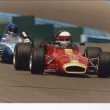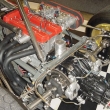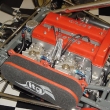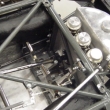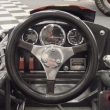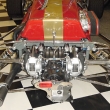1971 Brabham BT-35 Formula B
Jack Brabham was a second generation Australian. His greengrocer father taught him to drive at the age of twelve. After spending two years in the Air Force, Jack set up a small repair business and was approached by American Johnny Schonberg to build him a car. Brabham did so, but not before Schonberg was talked out of competitive racing by his wife. This left Brabham with his own car and he decided to have a go for himself. His debut was at Paramatta Park Speedway and he was bitten by the bug. He entered the New South Wales Championship and was victorious in his first season. During his time spent on the local circuits, Brabham met Ron Tauranac and formed a partnership that would take them both to Europe and Formula 1.
In 1955 Brabham came to England for his GP debut at Aintree and soon joined the Cooper works team. Initially, he thrived at Cooper and in 1959 won the World Championship in a Cooper with a 2.5 litre Coventry Climax engine. In 1960, Brabham repeated this feat, his overall victory including an impressive five straight wins. Although he was triumphing at Cooper, Brabham was not happy. He decided to join up with Ron Tauranac and in 1961 formed Motor Racing Developments. They built one car, retaining the company name MRD, but gave their cars the marque name Brabham. Their aim was to build single seater and sports racing cars alongside a F1 team effort. Brabham’s rise during the mid 60s was meteoric and when the new 3 litre Formula 1 came into existence in 1966, Jack, in his own car powered by an Australian Repco Company engine, won the World Drivers Championship. He thus became the first driver to do so in a car bearing his own name. The following year the Brabham name was again victorious, this time in the hands of Denny Hulme. The partnership lasted until 1971 when Brabham sold his share and returned to Australia.
During this tremendously successful period in Formula 1, the company still managed to produce highly competitive customer cars such as the BT35 which came in three different versions, all produced in 1971. The BT35A was the American SCCA version, distinguished by its inboard rear brakes and Hewland FT 200 gearbox. Only three of these cars were ever built and were supplied with Ford Twin Cam engines. The BT35B is the Formula B/Atlantic version of the same car, of which a mere seven were built. This is the variation of the BT35 in the Mathews Collection. It has 13×10 front and 13×14 inch rear tires, outboard rear brakes along with the Hewland FT200 gearbox and is fitted with a Lotus Twin Cam engine. The largest production run was of the Formula 3 BT35C of which twenty seven were made. These had Hewland Mark 8 gearboxes.
All three of the BT35 variations are built in basically the same manner. The chassis is a bronze welded tubular steel space frame with the cockpit made from steel and steel sheet panels. The body is formed from three resin bonded fiberglass sections; the nose, separate from the cockpit section, and the undertray. This was the last Brabham to be built with a tubular chassis and proved immensely popular with independent drivers, especially outside of the UK.
